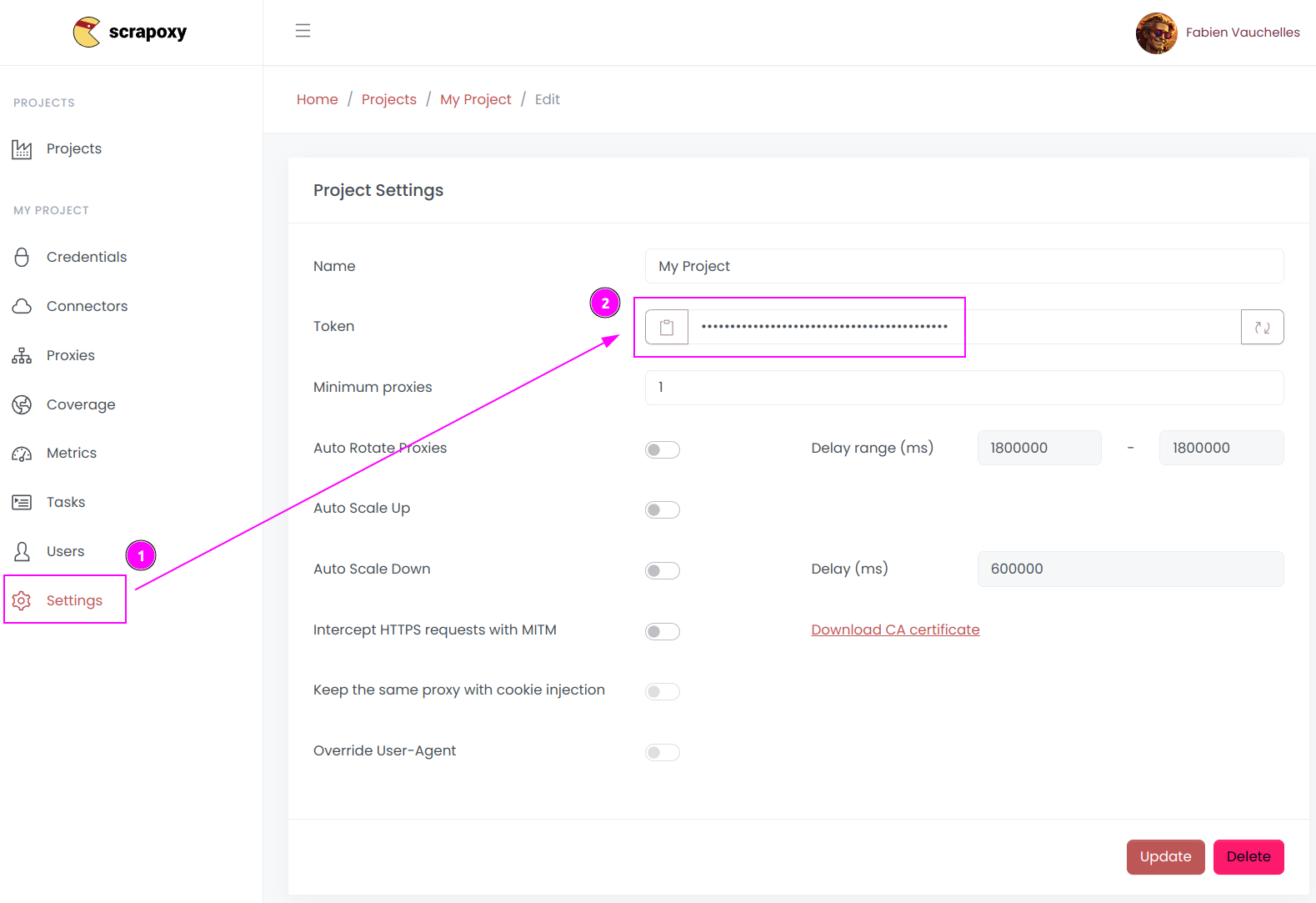Scrapy Integration
This tutorial uses the famous Python web scraping framework Scrapy.
Step 1: Install the framework
pip install scrapy scrapoxyStep 2: Retrieve project token

- Open Scrapoxy User interface, and go to the project
Settings; - Remember the project token (format is
USERNAME:PASSWORD).
Step 3: Create a new project
Create a new Scrapy project:
scrapy startproject myproject
cd myprojectAnd add a new spider:
scrapy genspider myspider mydomain.comStep 4: Add Scrapoxy usage
Edit myproject/settings.py and modify the following lines:
DOWNLOADER_MIDDLEWARES = {
'scrapoxy.ProxyDownloaderMiddleware': 100,
}
SCRAPOXY_MASTER = "http://localhost:8888"
SCRAPOXY_API = "http://localhost:8890/api"
SCRAPOXY_USERNAME = "USERNAME"
SCRAPOXY_PASSWORD = "PASSWORD"Replace USERNAME and PASSWORD by the credentials you copied earlier.
Step 5: Remove blacklisted instances (optional)
Scrapy uses Scrapoxy's API to kill blacklisted instance.
Edit myproject/settings.py and add the following lines:
DOWNLOADER_MIDDLEWARES = {
'scrapoxy.ProxyDownloaderMiddleware': 100,
'scrapoxy.BlacklistDownloaderMiddleware': 101,
}
SCRAPOXY_BLACKLIST_HTTP_STATUS_CODES = [400, 429, 503]
SCRAPOXY_SLEEP_MIN = 60
SCRAPOXY_SLEEP_MAX = 180TIP
Add the HTTP status codes you want to blacklist in SCRAPOXY_BLACKLIST_HTTP_STATUS_CODES.
Scrapy will pause for a duration ranging between SCRAPOXY_SLEEP_MIN and SCRAPOXY_SLEEP_MAX seconds when no proxy instance is available.
Step 6: Auto-scale the scraping session (optional)
Scrapy can start instances at the beginning of a session and terminate them when the session finishes.
Edit myproject/settings.py and add the following lines:
SPIDER_MIDDLEWARES = {
"scrapoxy.ScaleSpiderMiddleware": 100,
}
SCRAPOXY_WAIT_FOR_SCALE = 120Scrapy will wait for a duration of SCRAPOXY_WAIT_FOR_SCALE seconds before initiating the scraping session, allowing time for the instances to be ready.
Step 7: Sticky session (optional)
Scrapy can use the same proxy instance for a set of chained requests.
Edit myproject/settings.py and add the following lines:
SPIDER_MIDDLEWARES = {
"scrapoxy.StickySpiderMiddleware": 101,
}Step 8: Integrate scrapy-impersonate (optional)
The library scrapy-impersonate is a Scrapy download handler. This project integrates curl_cffi to perform HTTP requests, so it can impersonate browsers' TLS signatures or JA3 fingerprints.
To use it, first install the package:
pip install scrapy-impersonateAnd add the following lines to settings.py:
TWISTED_REACTOR = "twisted.internet.asyncioreactor.AsyncioSelectorReactor"
DOWNLOAD_HANDLERS = {
"http": "scrapy_impersonate.ImpersonateDownloadHandler",
"https": "scrapy_impersonate.ImpersonateDownloadHandler",
}In your scraper, include additional metadata with the request, specifically setting the verify option to False within the impersonate_args. This will bypass SSL certificate verification.
class ExampleSpider(Spider):
name = "example"
allowed_domains = ["browserleaks.com"]
def start_requests(self):
yield Request(
url="https://tls.browserleaks.com/json",
dont_filter=True,
meta={
"impersonate": "chrome110",
"impersonate_args": {
"verify": False,
},
},
callback=self.parse
)In this example, the request will emulate a Chrome 110 browser, but you have the flexibility to choose from many other useragents.

 Scrapoxy
Scrapoxy